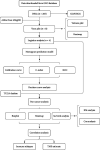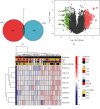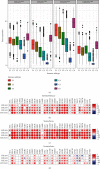Collagen Family Genes Associated with Risk of Recurrence after Radiation Therapy for Vestibular Schwannoma and Pan-Cancer Analysis
- PMID: 34691289
- PMCID: PMC8528601
- DOI: 10.1155/2021/7897994
Collagen Family Genes Associated with Risk of Recurrence after Radiation Therapy for Vestibular Schwannoma and Pan-Cancer Analysis
Abstract
Background: The safety of radiotherapy techniques in the treatment of vestibular schwannoma (VS) shows a high rate of tumor control with few side effects. Neuropeptide Y (NPY) may have a potential relevance to the recurrence of VS. Further research is still needed on the key genes that determine the sensitivity of VS to radiation therapy.
Materials and methods: Transcriptional microarray data and clinical information data from VS patients were downloaded from GSE141801, and vascular-related genes associated with recurrence after radiation therapy for VS were obtained by combining information from MSigDB. Logistics regression was applied to construct a column line graph prediction model for recurrence status after radiation therapy. Pan-cancer analysis was also performed to investigate the cooccurrence of these genes in tumorigenesis.
Results: We identified eight VS recurrence-related genes from the GSE141801 dataset. All of these genes were highly expressed in the VS recurrence samples. Four collagen family genes (COL5A1, COL3A1, COL4A1, and COL15A1) were further screened, and a model was constructed to predict the risk of recurrence of VS. Gene Ontology (GO) and Kyoto Encyclopedia of Genes and Genomes (KEGG) enrichment analyses revealed that these four collagen family genes play important roles in a variety of biological functions and cellular pathways. Pan-cancer analysis further revealed that the expression of these genes was significantly heterogeneous across immune phenotypes and significantly associated with immune infiltration. Finally, Neuropeptide Y (NPY) was found to be significantly and negatively correlated with the expression of COL5A1, COL3A1, and COL4A1.
Conclusions: Four collagen family genes have been identified as possible predictors of recurrence after radiation therapy for VS. Pan-cancer analysis reveals potential associations between the pathogenesis of VS and other tumorigenic factors. The relevance of NPY to VS was also revealed for the first time.
Copyright © 2021 Qingyuan Shi et al.
Conflict of interest statement
The authors declare no competing interests.
Figures









Similar articles
-
Identifying the mRNAs associated with Bladder cancer recurrence.Cancer Biomark. 2020;28(4):429-437. doi: 10.3233/CBM-190617. Cancer Biomark. 2020. PMID: 32390597
-
Bioinformatics analysis suggests that COL4A1 may play an important role in gastric carcinoma recurrence.J Dig Dis. 2019 Aug;20(8):391-400. doi: 10.1111/1751-2980.12758. Epub 2019 Jul 4. J Dig Dis. 2019. PMID: 31069993
-
Microsatellite analysis of recurrent vestibular schwannoma (acoustic neuroma) following stereotactic radiosurgery.Otol Neurotol. 2006 Feb;27(2):213-9. doi: 10.1097/01.mao.0000199753.44191.73. Otol Neurotol. 2006. PMID: 16436992
-
Stereotactic radiotherapy for vestibular schwannoma.Otolaryngol Clin North Am. 2009 Aug;42(4):655-63. doi: 10.1016/j.otc.2009.04.008. Otolaryngol Clin North Am. 2009. PMID: 19751870 Review.
-
Clinical and histopathologic features of recurrent vestibular schwannoma (acoustic neuroma) after stereotactic radiosurgery.Otol Neurotol. 2003 Jul;24(4):650-60; discussion 660. doi: 10.1097/00129492-200307000-00020. Otol Neurotol. 2003. PMID: 12851560 Review.
Cited by
-
Development of a prognostic prediction model based on a combined multi-omics analysis of head and neck squamous cell carcinoma cell pyroptosis-related genes.Front Genet. 2022 Sep 29;13:981222. doi: 10.3389/fgene.2022.981222. eCollection 2022. Front Genet. 2022. PMID: 36246601 Free PMC article.
-
Prognostic and Functional Analysis of NPY6R in Uveal Melanoma Using Bioinformatics.Dis Markers. 2022 Apr 8;2022:4143447. doi: 10.1155/2022/4143447. eCollection 2022. Dis Markers. 2022. PMID: 35432628 Free PMC article.
-
Exploring the role of differentially expressed metabolic genes and their mechanisms in bone metastatic prostate cancer.PeerJ. 2023 Apr 12;11:e15013. doi: 10.7717/peerj.15013. eCollection 2023. PeerJ. 2023. PMID: 37070095 Free PMC article.
-
MicroRNAs Promote the Progression of Sepsis-Induced Cardiomyopathy and Neurovascular Dysfunction Through Upregulation of NF-kappaB Signaling Pathway-Associated HDAC7/ACTN4.Front Neurol. 2022 Jun 9;13:909828. doi: 10.3389/fneur.2022.909828. eCollection 2022. Front Neurol. 2022. PMID: 35756932 Free PMC article.
-
Persistent Properties of a Subpopulation of Cancer Cells Overexpressing the Hedgehog Receptor Patched.Pharmaceutics. 2022 May 5;14(5):988. doi: 10.3390/pharmaceutics14050988. Pharmaceutics. 2022. PMID: 35631574 Free PMC article.
References
-
- Hani U., Bakhshi S., Shamim M. S. Steriotactic radiosurgery for vestibular schwannomas. The Journal of the Pakistan Medical Association . 2020;70(5):939–941. - PubMed
MeSH terms
Substances
LinkOut - more resources
Full Text Sources
Medical
Miscellaneous

